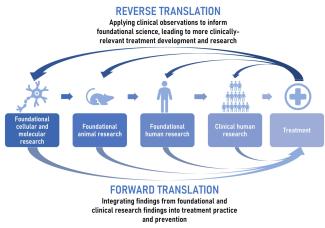Under the reverse translation paradigm, research becomes a continuous, cyclical process, in which new patient observations generate new testable hypotheses for foundational research, which, in turn, leads to the next generation of clinical trials, and ultimately to improved patient outcomes.
Our multidisciplinary research evaluates promising new treatments for neuropsychiatric disorders in vitro, in translational animal models of clinical syndromes, as well as in patient-centered clinical trials.
Translation between clinical practice and foundational research occurs at many levels, including from molecular and cellular research to animal research, human research, clinical trials in patient populations, and population-level community practice (bench to bedside to community).

